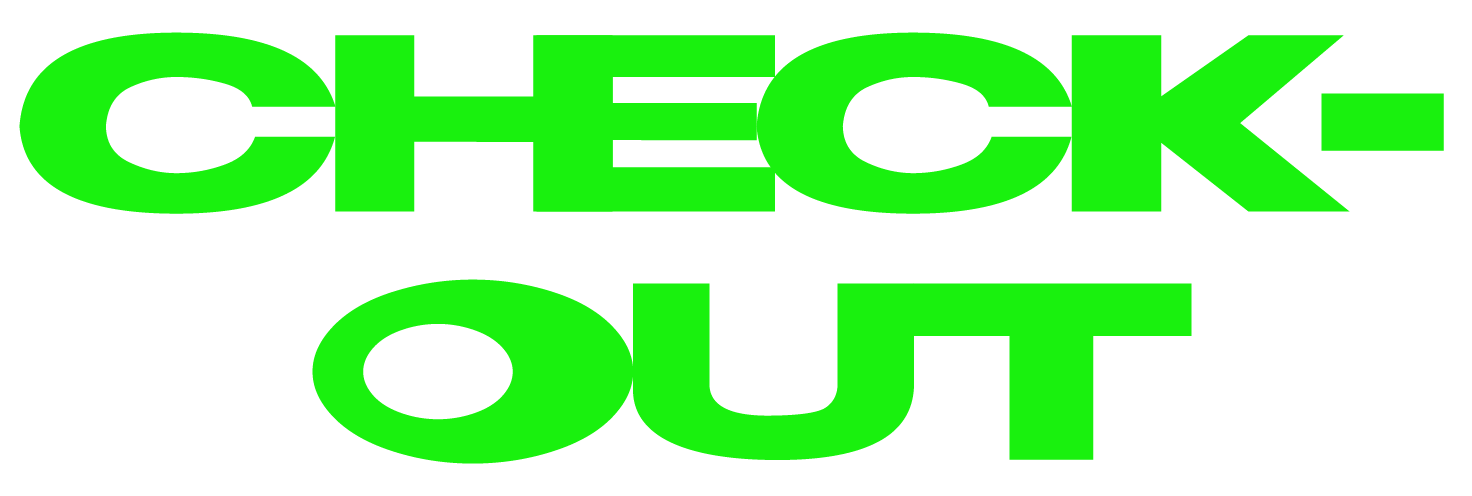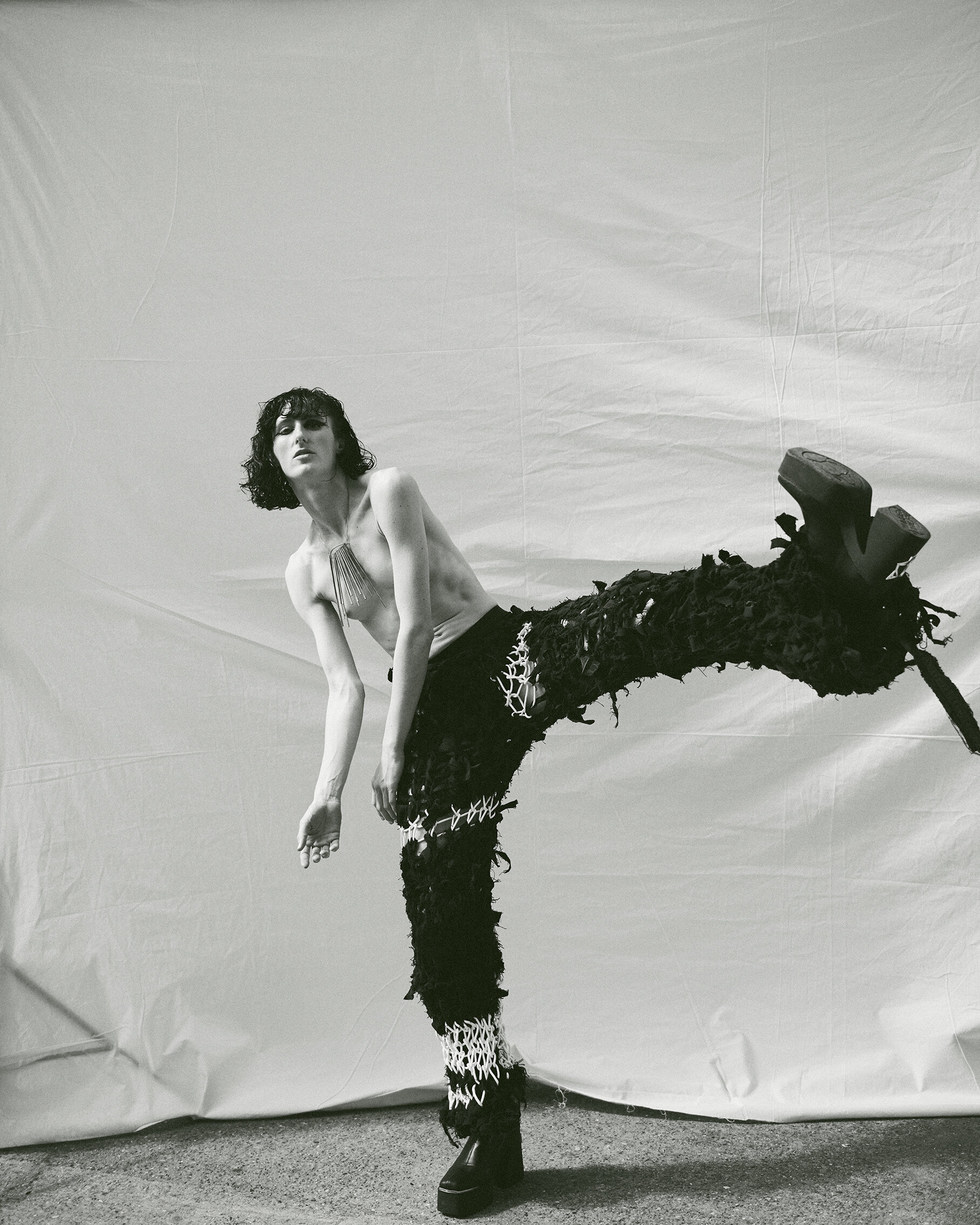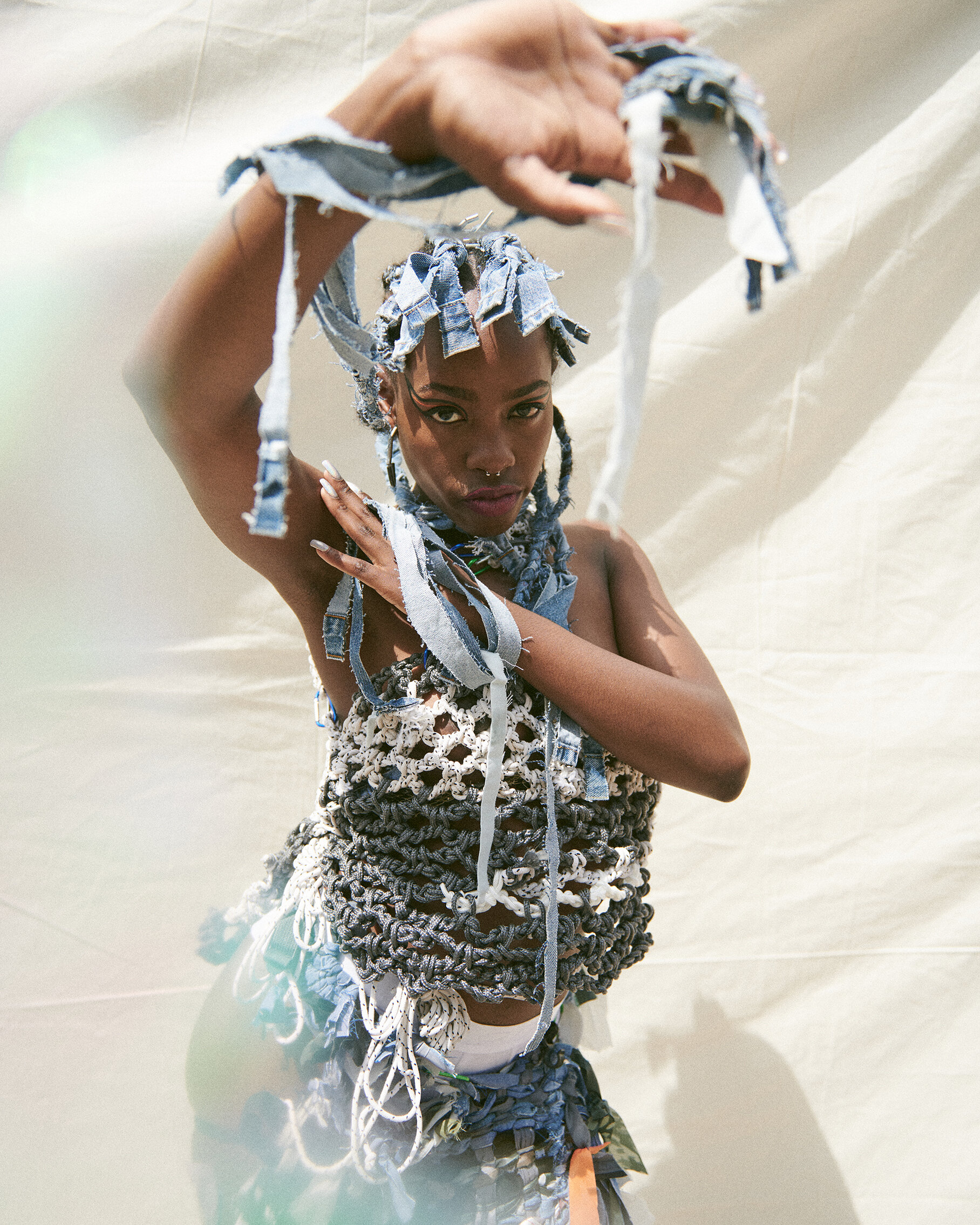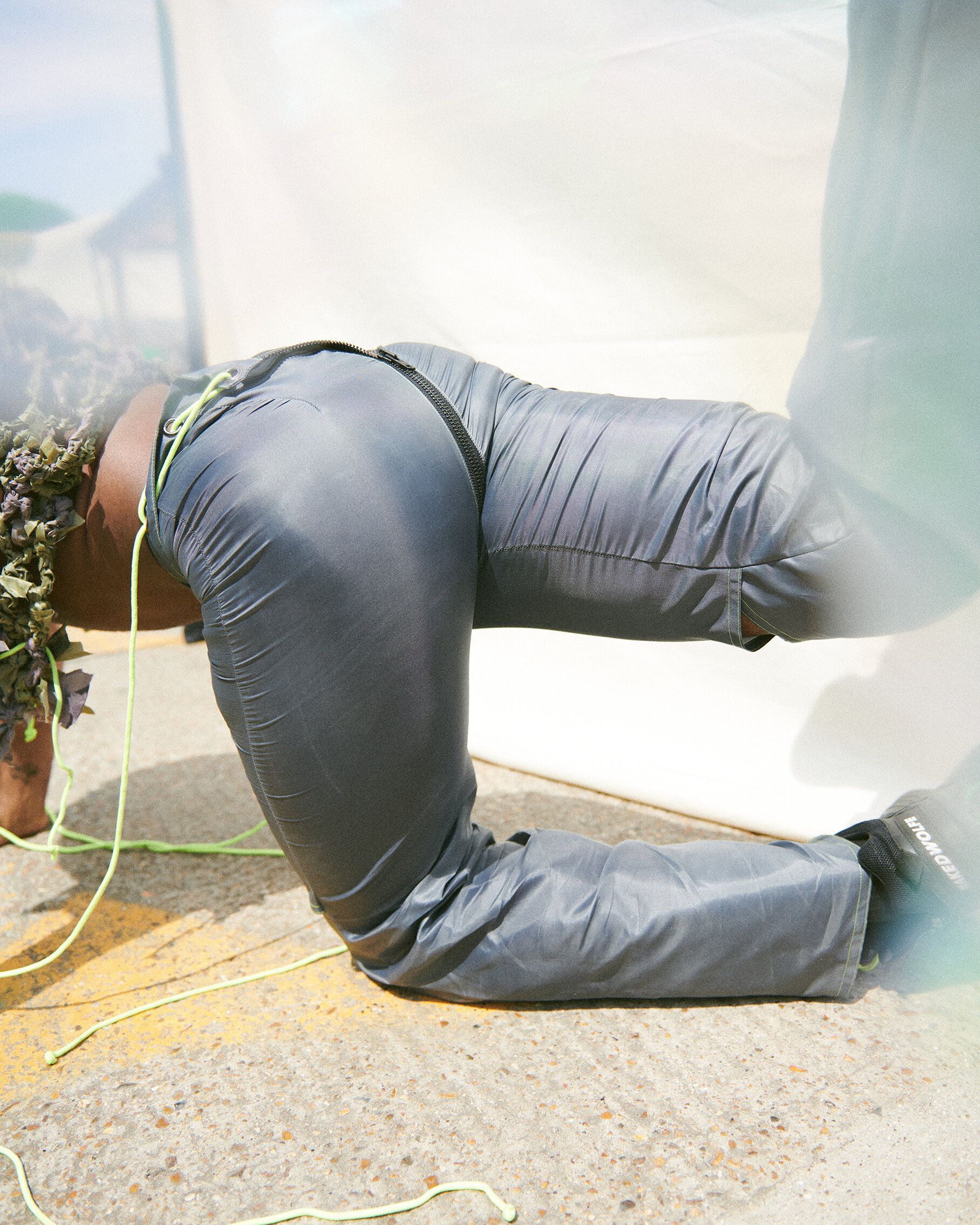From high-vis to high fashion, Chloe Baines is designing a gender-fluid future
Whilst some are feeling the post-festival blues and hangovers, Chloe Baines is feeling her most creative and is transforming disused tents into a new collection that promotes sustainability.
While temperatures soared into the 30’s (that’s hot for the UK, alright!), and I slowly melted into my faux leather chair, I found myself quoting Elektra Abundance from Pose: “It feels like someone’s turned this thermostat up to inferno!!” On the other end of the wireless web, upcycle designer CHLOE BAINES was hurtling through a sweltering London to our interview. During this busy season of summer collection releases, shoots and preparations for the upcoming shows, the glamour of fashion really comes crashing to a hot mess of reality. Nevertheless, Baines jumped straight into our interview with the same vivacious energy she has applied to her career and success. The ethos of her brand focuses on designing clothes that promote sustainability and gender fluidity and is carried through from her debut collection, In Tents: The After Party to her most recent, Pegged. We first talked of the background that led to the LONDON COLLEGE OF FASHION alumna’s success.
Chloe Baines: I’m originally from Coventry and I moved to London five years ago when I started at LCF. I try to get back to the Midlands because I’m quite close to my parents and it’s nice to have a break from London sometimes. I also come from a working-class background so it’s nice to stay grounded. I do find that when working in fashion you can get a warped perspective sometimes.
May Garland: Did you always know you wanted to go into fashion?
CB: It sounds really cliché but I did! Ever since I was making clothes for my dolls with my Nan. I went through a stage during my foundation course where I wanted to go into fine art and fashion. So, my first real exposure to fashion was at school where I did textiles at GCSE and product design at A level. When it came to applying for universities, my portfolio was very fine art heavy, but I always wanted to do fashion and so I took a lot of inspiration from fine art when it came to coming up with concepts for my designs.
MG: Can you tell me a bit about your journey into creating your own brand, how did this all begin?
CB: It really began at uni, I also saw how difficult it was to get into the industry. I think a lot of people at uni aren’t sure what they want to do. For me, I always knew I wanted to be a fashion designer. I had this seminar with Christopher Raeburn and I remember thinking he was an absolute genius with his upcycle parachute stuff. That was the ethos I wanted for my own brand and I think it all just naturally progressed from my graduate collection.
MG: Let’s talk about your graduate collection, In Tents: The After Party. This was made entirely from tents left at festivals, right? A genius idea! How did you come up with this?
CB: I went to a festival with my friends and on the last night, they showed us lots of footage of the tents that had been left behind from previous seasons. That killed the party mood a bit but was really incredible and definitely made us think a lot more about our carelessness at festivals. The next morning we packed up our things to leave and noticed these guys next to us left their huge teepee, so we were like we’re going to take that if they’re not. As we were taking it down, I noticed all the stitching and thought if all this material had been stitched together to make a tent then surely this can be stitched and reworked to make clothes.
Listening to how Baines conceptualised her collection, I had a flashback to those sweaty festival days pre-covid. Hangovers, fatigue and dehydration were always the final hallmarks of festival season, and as people dragged themselves home, the fields once filled with good vibes and good music became a graveyard of the skeletal remains of teepee tents and crushed beer cans. Maybe it’s just the summer heat, but global warming feels even more oppressive today from our truthfully unsustainable lifestyles. However, Baines is optimistic on the future of fashion and sees sartorial potential in discarded materials.
MG: Walk me through the process of creating a wearable garment from a used tent.
CB: The process was really challenging at first because of the amount of material, but I knew I wanted to make jewellery from the tent pegs. When I started experimenting with cutting regular pattern pieces out of the tent, things weren’t really working, but then, I made my breakthrough with my one-shouldered orange dress which you can see in my collection, In Tents. This worked because I used the tent silhouette on the body instead of using the body to dictate from the tent. I was getting more inspiration from the tents and then adapted pieces from the collection for Selfridges’ sustainability initiative, Brand New Things. So yeah, it was a lot of draping and a lot of collaboration.
MG: What are your thoughts on sustainability in the fashion industry?
CB: I’ve seen a massive increase in the interest of sustainability in fashion and it’s great that people are more aware of it. I think it’s becoming less of a classist thing where sustainable clothes are just restricted to those with a higher budget, I definitely felt some guilt with this. But I have seen a lot more people shop second hand which is great. However, I still think we have a long way to go.I also work at Selfridges as a freelancer and it’s interesting to see how they’ve incorporated more sustainable practices into their business. They did the massive Project Earth and collaborated with big fashion houses like PRADA to do the Re-Nylon sustainable project. The rental service has been introduced as well; although, there is a debate as to whether this is more sustainable. But yeah, people have definitely challenged this and upcycling can be so fun! It's great to challenge the way you view fashion as a consumer.
MG: How did your previous work experience with designer GARETH PUGH and your bachelor’s degree from the London College of Fashion help to shape you as a designer?
CB: Working for Gareth Pugh was definitely the most valuable experience of my career because that was where I felt the most inspired. I really admire Gareth’s concepts and his use of materials. I remember when I worked there I was collecting materials from different suppliers around London and I remember thinking what on earth is Gareth going to use this for and what has this got to do with fashion? But it always had a specific purpose. This taught me you don’t always have to use materials in the purpose they were originally intended for. So, that’s had a huge impact on the way I design and I’ve applied this thought process to my upcycling methods. As far as my degree is concerned, this was very different to my abstract and conceptual foundation course of Fine Art at Coventry University. Whereas at LCF, it was a lot more commercially driven, which I thought maybe wasn’t the best decision at the time, but in hindsight, it was really useful in teaching me how to engage with consumers.
MG: What do you think of the importance of fashion education? There can be a lot of stigma around it from people outside of the industry and also a lot of competition between different institutions and courses.
CB: In order to be part of the fashion industry you need to have an understanding of how the industry works. In that sense, it can be frustrating to work particularly hard on that practice and then someone who’s got a million Instagram followers comes along and can get more credibility over someone who’s studied for 10 years. But I think creative practice in a general sense is really important because anybody who’s interested in the creative industry can be a part of it at any age. We have seen a shift in large fashion houses employing the younger generation because they have that fresh perspective. But to run a brand you need to know the different aspects of running a brand. You can’t hire people and reach out to suppliers without this knowledge. I wouldn’t be where I am today without this education.
MG: Talk to me about your new collection, Pegged. How did you go from high-vis jackets to high fashion?
CB: I really wanted this to be a more personal project with exploring gender through fashion. I’ve always been inspired by construction-wear and how hyper-masculine it is; therefore, I wanted to challenge this and make it really queer. It was really funny I went to this big queer rave event with my friend and collaborator Joe Wood and wore some pieces from Pegged. At the end of the night when I was waiting for my taxi, we passed a load of construction workers. The contrast was hilarious of what they wore and what we were wearing as it was such a juxtaposition, but obviously my outfit was inspired by their uniform. I loved that because it felt like my designs went full circle.
MG: Your designs encourage discussions on gender and sexuality as well as sustainability. Is the future of fashion gender-fluid in your opinion?
CB: I really think so! For me, something that’s always intrigued me with fashion is that it’s such a powerful way to communicate who you are and how you want people to treat you. I really look up to my mum who’s such a powerful woman and the best advice she gave me was “if you want people to take you seriously, wear a power suit”. I think having such a powerful feminine influence in my life and surrounding myself with the queer community has been an amazing personal and professional development for me.
Baines’ confident demeanour and passionate tone when speaking about gender and equality echoes her strong feminist upbringing. As well as promoting gender fluidity in her professional projects, Baines hopes to involve herself with more workshops and community projects to support the rights of the LGBTQ+ community, which were put on hold due to the pandemic. Her personal journey through exploring her own identity and attending regular LGBTQ+ rights protests have also been influential and inspired her collections.
CB: It’s been really powerful to meet people in the industry who identify as queer. I chose to include a couple from Coventry, Lynne Graham and Raymond Graham, in the Pegged video. They are friends of mine and some of the first people I met who were part of the queer community. They were such a big part of my personal development, so it was really important for me to include them in this project.
MG: Society still has much further to go to reach gender equality, how important is fashion in advocating the rights of the LGBTQIA+ community?
CB: Fashion is great to express who you are, but there is also a juxtaposition with the rigid societal norms around fashion and gender. In the fashion industry, it feels safe to explore this and challenge this, whereas outside of this bubble it can be quite dangerous. But it’s definitely something people are starting to break boundaries with. Designers aren’t so much doing womenswear and menswear anymore and seeing high-profile designers do more mixed gender collections is a really positive manoeuvre. Although we see these boundaries being broken down on the runway, in ‘real life’ it’s not really like that. So, I think fashion is important for self-expression, but still responsible for gender inequality.
MG: Running your own brand must be overwhelming sometimes, how do you like to de-stress and switch off?
CB: I’m really bad at this haha. It’s really difficult to switch off running your brand because you care so much. However, I’ve started to switch off my phone when I’m out with friends and running really helps me blow off steam. I’m also running the London marathon (cheeky plug for sponsors haha) but running is great for my mental health. The fashion industry gives you a strange feeling that you constantly need to prove yourself and it’s only recently that I’ve stopped feeling like that through knowing my own self worth, giving myself credit for my work and giving myself that much needed time off.
MG: What’s next for Chloe Baines?
CB: I will continue on my upcycle journey. With no festivals I was forced to go in another direction for materials; however, this was actually really valuable because it meant I got to work with the zero waste, sustainable clothing company, E.L.V denim who gave me their denim scraps to make Pegged which I’m very grateful for. I want to keep exploring with different materials and continue to do exciting collaborations, so keep an eye out for that. But above all, I’m trying to take this all at my own pace and the pace of the world.
Photography by BEX ASTON
Creative direction and fashion by CHLOE BAINES
Styling by PUPPER BITCH
Featuring AMI BENTON, ALIZÉ, DAZE HINGORANI at CRUMB AGENCY, RAYMOND GRAHAM, LYNNE GRAHAM, OMAR PHILLIPS, PFION VINCE and SHANI ROSS
Hair by International Artistic Director EFI DAVIES and the TONI&GUY Session Team ALESSANDRO BARCA and DARJA LAETT using label.m Professional Haircare
Make-up by MIN SANDHU
Manicure by KIM G MACIAS
Movement direction by PFION VINCE
Shot at THE CAUSE
Welcome to CHEW THE FAT WITH…, our long-form series where we invite you to sit down with fashion’s next generation as they dig deep into their memories. To chew some fat - an informal conversation brimming with small talk - we encourage you to pull up a chair and take a big old bite as we spill the tea on the life and work of the industry’s need-to-knows. Just remember to mop up after yourself.

















